'Man
is a mortal being', however, those who through their efforts work
for the well being of their relatives, friends, acquaintances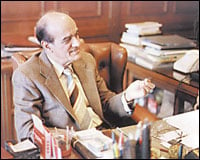 and
the society at large, are remembered for a long time, even after they
depart to heavenly abodes. and
the society at large, are remembered for a long time, even after they
depart to heavenly abodes.
Mir Khalil-ur-Rahman, the founding father of the Jang Group of Newspapers,
during his journalistic career which is spread over more than fifty
years, succeeded in registering his contribution in almost all fields.
Mir saheb was admired by many. His long list of admirers include well
known personalities from Jamiluddin Aali to Nisar Ahmad Zuberi, Qutbuddin
Aziz to Farhad Zaidi and S M Fazal, Shamshad Ahmad to Yunus Riaz.
All these personalities have paid tributes to Mir Khalil-ur-Rahman
on the occasion of his 16th death anniversary, which will be solemnly
observed on 25th January, 2008.
Veteran banker, celebrated poet, popular author and prolific writer
(like Agatha Cristie) Jamiluddin Aali said that Mir Khalil-ur-Rahman
was the product of several special factors of his time. It was a very
particular time in history, when Mir saheb embarked upon his business
in the capital of the then British India. At that time the struggle
by the All India Muslim League for the Pakistan Movement was at its
peak. This movement was opposed by the Indian National Congress led
by Pandit Jawaharlal Nehru and his colleagues.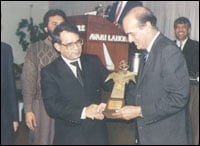
Mir saheb started his professional career with the 'Daily Jang' in
Delhi. He was a very talented man with a mission, since he started
his newspaper to aid the liberation of India from the British yoke
and the creation of a separate homeland for the deprived Muslims of
the sub-continent under the leadership of the Quaid-i-Azam Mohammad
Ali Jinnah.
Former Senator Jamiluddin Ali who had been very close to Mir saheb
has been a regular writer in the 'Daily Jang' for several decades.
Talking about his personal experience with Mir saheb, Aali said, "Mir
saheb allowed his columnists to be completely free, almost completely.
They could write against the ministers, presidents or the policy of
the country or any other institution and he would not interfere".
"However, if the situations demanded or he was pressurised by
the government in power, Mir Saheb would then call his executive editor
and say "Yar Yousuf Siddiqui Saheb, zara sauch samajh liya karo,
akhbar chalana hai (Please try to understand that we have to run our
paper)" but MIR saheb would never say that something wrong had
been published.", says Aali.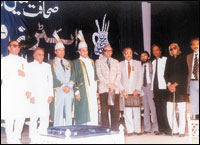
Aali said that the Daily Jang's office was more than Mir saheb's second
home. Gradually and slowly, his paper gained importance and he started
meeting VVIPs from other countries. When the President or Prime Minister
of Pakistan went abroad for official trips or when the foreign dignitaries
visited Pakistan, Mir Khalil also got the opportunity to meet all
these people thanks to his publication the 'Jang' which was at the
peak of success. His beat reporters were assigned to cover all such
events, despite that he covered the event himself.
Another important quality of Mir saheb was his capacity to manage
money. Aali was associated with him for over a period of four decades
and during this period he never saw him waste money.
A particular trait of Mir saheb, which Aali appreciated, was that
he gave very strict training to his sons, Mir Javed-ur-Rahman and
Mir Shakil-ur-Rahman. He constantly administered their work. During
the office hours he treated them like employees and did not mix his
personal relations with his professional life. It was this training,
which helped Javed and Shakil, achieve success at a very young age.
Modern Urdu journalism owes a lot to the few stalwarts like Maulana
Abul Kalam Azad, Maulana Mahboob Alam and Maulana Zafar Ali Khan.
All of these made lasting contributions, which helped Urdu journalism
become what it is today.
Prominent educationist, writer, author and intellectual Prof Dr Nisar
Ahmad Zuberi, who persued journalism at a young age, expressed his
views about the king of the 'Jang' empire, Mir Khalil-ur-Rahman.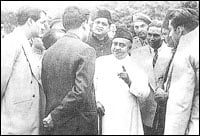
Prof Zuberi's research proves that it was Maulana Azad who helped
in the familiarisation of the use of standardised printing. Thus he
helped the editors accept the fact that modernity was bound to prevail.
On the other hand, Maulana Mahboob Alam attained great success by
pioneering the 'PENNY PRESS' in Urdu. With his 'PAISA AKHBAR' he made
the daily newspaper an affordable commodity for the masses.
Maulana Zafar Ali Khan attracted the masses with his original journalistic
poetry. He is known to have electrified the people with his interesting
and highly charged poems like "Apni dokaan barha lo lala".
All these three personalities excelled in pre-Pakistan Urdu journalism.
Hence, they are rightly considered the pillars of the Urdu press.
History will always bear witness to their greatness.
Post-Pakistan Urdu journalism since 14th August 1949, however, is
a different story altogether. This period is dominated by Mir Khalil-ur-Rahman's
achievements. His humble newspaper, which was almost a non entity
in the undivided India, was destined to develop into an empire of
lasting strength. Zuberi says that with his untiring efforts as an
editor, an administrator, a public relations officer, a human resource
expert, an organiser and a planner, Mir saheb has set many examples
of safe, balanced and interesting journalism for the masses. He will
always be remembered for his ability to build an empire of great social
and political value.
Nisar Ahmad Zuberi who had the privilege of serving in various capacities
in Jang and also as the editor of largest circulated weekly 'Akhbar-e-Jehan'
before joining the Mass Communication department of Karachi University
says, that one thing which placed Mir saheb on a high pedestal, was
his mission of producing a newspaper for the masses, the Ramzanis
of Majeed Lahori. Quite like the Benjamin days of the 'New York Sun'
(1833), Mir Khalil-ur-Rahman believed in expanding the frontiers of
Urdu journalism to include every thing that may interest the common
reader. May be unscientifically prepared, but he had a clear profile
of a typical Urdu newspaper reader in his mind.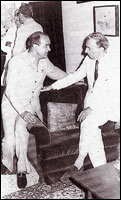
Mir saheb undoubtedly had a unique acumen to save the newspaper from
harsh government actions and at the same time ensured that it remained
popular among the masses.
It was common for all seniors like Prof Zuberi, who served the Jang
group from 1965 to 1984, to come in contact with Mir Saheb a couple
of times daily since he believed in staying in close contact with
his employees.
Pakistani newspapers, during that period had to brave intimidation
almost everyday. From Ayub Khan to Zia ul Haq, almost all the rulers
and top bureaucrats were keen to pressurise 'Jang' into following
the officials' line. In those difficult days, 'Jang' had to walk on
the tightest rope without forgetting the demands of its hundreds and
thousand of readers. But it was Mir saheb's balancing expertise that
saved his newspaper from the wrath of the likes of Nawab Amir Mohammad
Khan of Kalabagh, the powerful governor of West Pakistan. In this
regard, senior journalist Syed Mohammad Taqi wrote editorials with
non-committed excellence and Iftikhar Ahmad Adani and others like
him taunted these kinds of editorials with their hilarious comments
like "Agha Taqi key bagh mein kawwa halal hai."
Qubuddin Aziz who is a senior citizen, widely respected intellectual,
a journalist and a former diplomat has been associated with Mir saheb
since the formative years of Pakistan.
Octogenarian, Qutbuddin Aziz is of the view that Mir saheb commands
a position of high eminence among the builders of the fourth pillar
of the state of Pakistan. Mir saheb not only nurtured and expanded
the Jang group of newspapers but also trained various teams of veteran
journalistic professionals who are now serving the Pakistani press
and are winning meads of praise not only for themselves but also for
the man who took them under his wings and inducted them into the world
of Pakistani journalism.
One of Mir Saheb's unique traits was the fact that he had an excellent
memory and remembered the names of many of his newspaper employees.
He strongly believed that the press workers and the working journalists
of his newspaper should be paid well so that able men and women with
talent for journalistic writing may be drawn to join journalism in
Pakistan.
Septuagenarian journalist, writer, author and enlightened intellectual,
Farhad Zaidi quotes Mao Tse Tung, one of the great revolutionary leaders
of 20th century, "Saving a newspaper is like steering a ship
caught in stormy waters". It is the captain's duty to see that
the ship does not crash against the rocks or run aground. Mir saheb
was the captain of "Jang" and he captained his ship with
remarkable acumen, great perseverance, and a spectacular capacity
for hard work.
Veteran journalist and serving editor of the Premier Eveninger Daily
News, S.M. Fazal was among the first few people who were employed
in the popular paper since its publication in October, 1962. Fazal
saheb said that, Mir Khalil-ur-Rahman was a keen collector of the
gems of the journalistic world. As a result, he succeeded in forming
a team of senior and qualified journalists for the Daily News, his
first venture in English Journalism.
Shamim Ahmed (first editor of Daily News), Khawaja Ibtisam Ahmad,
Suleman Ahmad Minai, M.T. Bokhari, Zamir Niazi and Mohammad Ali Siddiqui,
were among those who had been working for other newspapers prior to
joining the "Jang", while S M Fazal, Wajid Shamsul Hassan,
(Editor Daily News from 1968 to 1988), Mohammad Jami (Executive Editor
Daily News from December 1988 to January 1990) and Ali Iqbal Siddiqui
were among those who started their journalistic career with Daily
News and achieved professional success to a large extent due to the
encouragement and patronage they received from Mir Khalil-ur-Rahman.
S M Fazal revealed that Mir saheb allowed complete freedom to the
editors and their teams. He did not practice or believe in imposing
his own opinions. He even respected the junior reporters and treated
them as colleagues. He was able to create a great team thanks to his
professional experience.
Mir saheb closely monitored the news coverage of all the papers including
'Daily News' and listened to all important broadcasts, particularly
Radio Pakistan, BBC, Voice of America, All India Radio etc. Along
with this, he also read rival newspapers and got very angry if an
important story was missed out or was not properly covered by his
staff.
Senior journalist and editor of the first commercial Urdu daily "Beopar"
Yunus Riaz said that, Mir Khalil-ur-Rahman was fortunate enough to
attract veteran journalists.
Mir saheb made sure that he was involved in every facet of newspaper
making, including production, coverage, display and distribution of
the newspapers. It was for this reason he kept in touch with everyone,
from the editor to the messengers serving the Jang group. All of his
workers were free to meet him and discuss their official as well personal
problems with him.
Yunus Riaz who served the Jang group from 1965 to 1990 and retired
as an executive editor said that, Mir saheb covered every important
function himself and also took notes of the speeches made. He asked
his editors to send him the report filed by the beat reporters and
he sent it back to them after adding points that had been missed out
by the reporter.
Shamshad Ahmed consultant, Federal Tax Ombudsman secretariat, had
an association with Mir Khalil-ur-Rahman for a long time. He says,
that Mir saheb is one of those memorable personalities who are not
only loved in their life time but are also remembered even after their
departure to heavenly abodes. Mir saheb's old friends still cherish
the good old days that they spent with him in Pakistan and abroad. |

